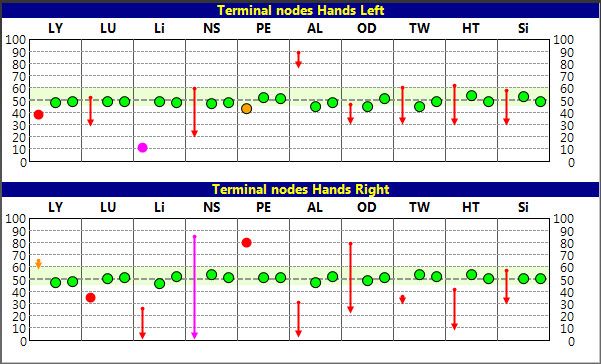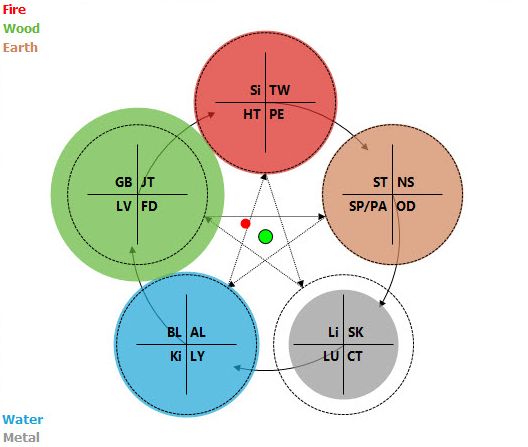Holimed EAV devices
Facts about electroacupuncture according to Dr. Voll (EAV)
Electroacupuncture according to Dr. Voll (EAV) was developed in the 1950s. It uses the fact that the surface points of acupuncture and other EAV measuring points on the skin show different electrical behavior compared to that on the normal skin surface. For example, the displayed value will change very strongly when you change the pressure of the probe on normal skin. In contrast, varying the pressure of the probe will change the measured value only slightly at the acupuncture points and so-called EAV points that are close to the surface of the skin. This phenomenon is called the plateau effect of EAV and is easy to verify. You can find further information on the plateau effect here.
In principle, EAV measures electrical resistance. When carrying out his measurements, Dr. Voll noticed that most readings appeared around a certain resistance value. This was then labelled the “normal value” in EAV.
It lies at around 92kOhm*. To make the measurements easier to read and interpret, EAV transforms and standardizes the measured values on a scale from 0 to 100. The mean value, that is, 50, is assigned to the 92kOhm. Hence, the scale is divided into two parts:
- the range from 0 to 92kOhm and
- the range from 92kOhm to about 560kOhm.
To display the different value ranges on either side of 50 on a linear scale from 0 to 100, every EAV device has to have a built-in nonlinear transformation function (as defined by Dr. Voll in the 1950s). Without this transformation function, it would be impossible to evaluate the measured values.
The measuring current
The traditional “old” EAV used measuring currents in the range from 5 to approximately 16 microamperes with a mean value of about 10 microamperes. Dr. Kramer already pointed out in the 1970s that this was far too high. By applying a special adaptation of the measurement method, Holimed has managed to reduce the measuring current to about 2.5 microamperes (almost constant over the entire measuring range). This low-power mode is available in all Holimed EAV devices. In the biocheck group of EAV devices, the mode can be switched to the old 10 microampere version when needed. This helps users if they occasionally have to upgrade old equipment.
Calibration
EAV measurement stands or falls with the calibration of the equipment. This is particularly important, because EAV is an absolute measurement method in which all values on all devices should be comparable anywhere in the world.
This is why all Holimed EAV devices are calibrated over the entire range.
If you use an EAV device from another manufacturer, you can check the calibration of the instrument quickly with just a few cheap resistors from a do-it-yourself electronics store. For more information on EAV calibration, click here.
The indicator drop
In addition to measuring the stable values, electroacupuncture according to Dr. Voll (EAV) uses a particular phenomenon: Working with direct current (albeit a very weak one) always leads to an electrochemical depolarization after a certain measurement time. The effect usually occurs only after a few seconds. But there are also cases in which the depolarization takes place immediately and the electrical resistance of the measuring point rises quickly. In electroacupuncture according to Dr. Voll (EAV), this effect is called an indicator drop. The reason for its occurrence is that as resistance increases, the measured current decreases and therefore the value displayed drops. The magnitude of the pointer drop is a measure of the significance of an irritation.
 In this example, the indicator drops are represented by arrows of different lengths. The graphic representation shows the overall situation at a glance.
In this example, the indicator drops are represented by arrows of different lengths. The graphic representation shows the overall situation at a glance.
.
The resonance test
One phenomenon in the energy test procedure still has an unknown cause: If a suitable test preparation is inserted into the test setup, then the previously tested energetic imbalance disappears.
- In kinesiology, for example a “weak” muscle response changes to a “strong” one.
- In the Japanese RAC-pulse test, a special pulse wave can be palpated.
- In EAV, an energetic irritation value changes almost immediately to the normal EAV value.
IIn the graph depicting the measured values, these normal values are represented by the green dots. Before bioresonance, EAV users were restricted mainly to working with test preparations or carrying out time-consuming meditative exercises or acupuncture. As a result, most EAV users have hundreds of test preparations, and finding the right preparation is time-consuming if no short cuts or tricks are available. However, by using the short cuts or tricks taught in professional seminars or in the Holimed seminar book, we can reduce the effort required to a few minutes. Click here for further information on the seminar book.
Bioresonance additionally has so-called bioresonance programs. The RemiWave series of bioresonance devices also offer the additional Holimed WaveScanner. This gives you the opportunity to find the one right program out of the millions of possible bioresonance settings in just a few steps. The test process takes less than 2 minutes.
5 Element Theory
The five-element theory diagram presents an overall view of the energy balance or imbalance. The differences in the sizes of the element circles show the conditions. The so-called elements are given historical names derived from Chinese teachings. Five-element theory is also known as the theory of the five phases of transformation.

EAV (Electroacupuncture according to Dr. Voll) has more meridians or so-called “EAV vessels” than TCM. Therefore, five-element theory was extended by Martin Keymer and others.
Drawing a five-element graph was previously tedious and inaccurate. You were limited to estimating the approximate tendencies on the basis of interviews. Holimed has succeeded in deriving the five-element graph from the EAV measurement via a mathematical method and displaying it on the screen.
You can see the advantage of the method in the example shown in the image. Although the meridians of the individual elements can have “local” energetic irritations in the EAV readings, in the overall view, they appear as locally balanced. In other words, taking a global view, a balanced element may still show various irritations in the measured values. Nonetheless, the energetic potential of such an element is within the normal range.
However, two elements in the image differ clearly from the “normal level.” In this case, the cause can be found in the so-called control cycle of five-element theory.
For the EAV resonance test, this means that initially you can ignore the local irritations of the meridians of the apparently balanced elements. Instead, focus on the meridians of the elements that differ from the normal value. In the example, these are the meridians of the elements “wood” and “metal.” In system-wide irritations, the rule is that a whole series of other irritations will automatically return to the energetic balance through first balancing such elements. This is known in five-element theory as the so-called remote effect of stress factors. Hence, including five-elements theory in EAV leads to a significant time advantage. Additionally, you can trace the trend over multiple sessions and discuss it with your client in great detail.
For more information on EAV
Much research on EAV has been carried out over the years. In part, this has also been scientific research. If you are interested, please ask for the extensive list here (German and English).
Equipment Safety
For safety reasons, all our systems are separated from 240V/110V mains and operate exclusively with standard batteries. Therefore, the power supply cannot interfere with the measurement. biocheck Pro is further connected via a fiber optic cable to the PC. This also rules out any electrical noise from the PC or leakage from the mains electricity supply.
